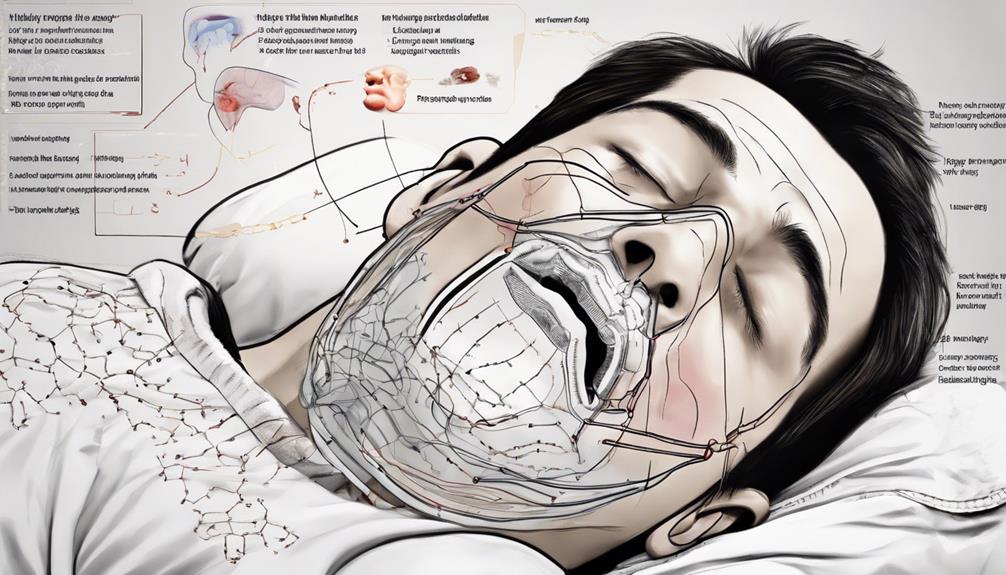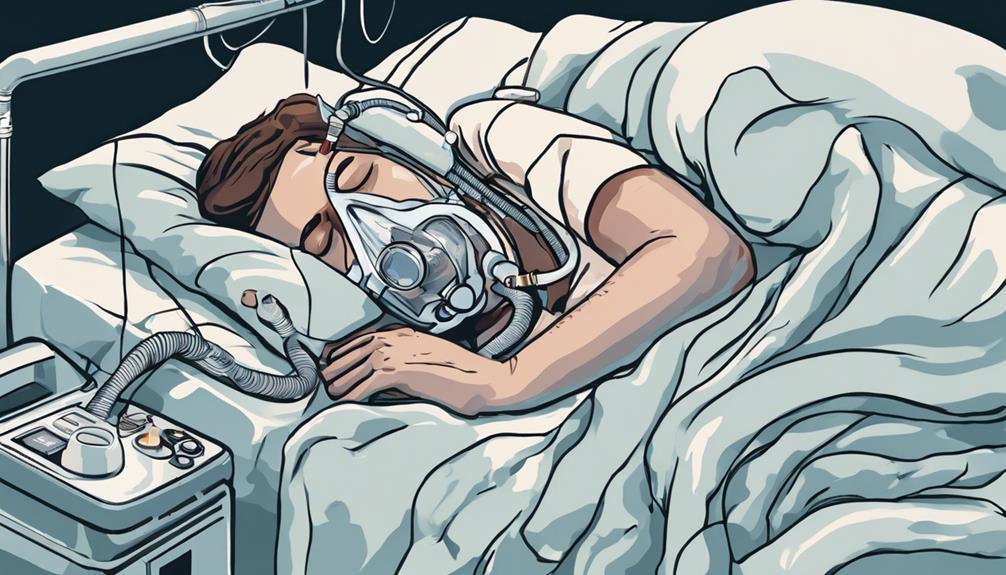Sleep apnea interrupts breathing during sleep. It's common worldwide. Two types: obstructive and central. OSA affects many U.S. adults, while CSA links to health issues. Symptoms include snoring, gasping, dry mouth, headaches, and sleepiness. Healthcare pros diagnose through history, physical exams, and sleep studies. Treatments like CPAP, surgery, lifestyle changes, and regular check-ups help manage it. Prevention involves lifestyle changes, weight control, and good sleep habits. Early detection improves outcomes. For more insights into sleep apnea and how to handle it effectively, keep exploring further resources.
Key Takeaways
- Sleep apnea is a common disorder with obstructive and central types.
- Symptoms include loud snoring, gasping for air, and dry mouth.
- Diagnosis involves history, physical exams, and sleep studies.
- Treatment options include CPAP therapy, surgery, and lifestyle changes.
- Prevention focuses on weight management, good sleep hygiene, and regular follow-ups.
Overview of Sleep Apnea
In this section, we'll explore the fundamental aspects of sleep apnea, a common sleep disorder characterized by breathing interruptions. Sleep apnea can be categorized into two main types: obstructive sleep apnea (OSA) and central sleep apnea (CSA). OSA, affecting 10-30% of adults in the U.S., is often linked to factors like obesity, older age, and anatomical issues such as a narrow airway. On the other hand, CSA, though less prevalent, is usually associated with underlying health conditions like heart failure or strokes.
Symptoms of sleep apnea, including daytime sleepiness, loud snoring, morning headaches, and gasping for air during sleep, can significantly impact one's quality of life. When left untreated, sleep apnea may lead to serious health conditions such as hypertension, heart disease, and diabetes.
Diagnosis of sleep apnea often involves a sleep study conducted in a specialized facility to monitor breathing patterns during sleep. Treatment options range from lifestyle changes like weight loss to medical interventions such as continuous positive airway pressure (CPAP) therapy. Proper management of sleep apnea is vital in reducing the risk of associated health complications and improving overall well-being.
Symptoms and Causes

Exploring the symptoms and causes of sleep apnea sheds light on the indicators and underlying factors contributing to this sleep disorder. Common symptoms of sleep apnea include loud snoring, gasping for air, dry mouth, morning headaches, insomnia, and excessive daytime sleepiness. Two main types of sleep apnea are obstructive sleep apnea (OSA) and central sleep apnea (CSA). OSA is often caused by relaxed throat muscles or tissues blocking the airway during sleep, while CSA occurs when the brain fails to send proper signals to the breathing muscles.
| Symptoms | Causes |
|---|---|
| Loud snoring | Obstructive sleep apnea – Relaxed throat muscles blocking airway |
| Gasping for air | Central sleep apnea – Brain signaling issues for breathing |
| Dry mouth | Risk factors: obesity, narrow airways, male gender, older age |
| Morning headaches | Family history of sleep apnea |
| Excessive daytime sleepiness |
Untreated sleep apnea can lead to complications such as severe daytime fatigue, irritability, concentration issues, and an increased risk of heart problems. If you or someone you know experiences these symptoms, it is important to seek medical advice for proper diagnosis and treatment. In some cases, untreated sleep apnea can contribute to life-threatening conditions such as strokes or heart attacks, raising serious concerns about long-term health. It’s natural to wonder, *can sleep apnea be fatal*? While the condition itself is not always deadly, its complications, particularly those related to cardiovascular health, can significantly increase the risk of premature death if left unmanaged.
Diagnosis and Testing
Let's explore how healthcare professionals diagnose sleep apnea using health history assessments, physical exams, and specialized testing techniques.
To begin, a thorough health history is essential to identify potential risk factors and symptoms that may indicate sleep apnea. Following this, a physical exam can provide further clues, such as excess weight or a narrow airway.
Polysomnography, commonly known as a sleep study, is a key diagnostic tool. In-clinic sleep studies monitor breathing patterns, oxygen levels, and brain activity during sleep, offering detailed insights into the presence and severity of sleep apnea. Additionally, at-home sleep studies can be conducted in a more comfortable environment while still providing valuable data for diagnosis.
It's crucial to mention that different types of sleep apnea, like obstructive and central sleep apnea, require distinct diagnostic approaches to guarantee accurate identification and effective treatment planning. By combining these diagnostic methods, healthcare providers can develop a thorough understanding of an individual's sleep apnea condition.
Management and Treatment

Our focus shifts to discussing the effective management and treatment options available for individuals diagnosed with sleep apnea.
- CPAP Therapy: Continuous Positive Airway Pressure (CPAP) devices are commonly used to treat both obstructive and central sleep apnea. These devices work by delivering a steady flow of air through a mask, keeping the airway open during sleep.
- Surgery: In severe cases of sleep apnea, surgical interventions like uvulopalatopharyngoplasty (UPPP) may be recommended to help alleviate symptoms. Surgical procedures aim to remove excess tissue in the throat to reduce airway blockages.
- Lifestyle Modifications: Making lifestyle changes such as weight management and avoiding alcohol can greatly improve sleep apnea symptoms. Maintaining a healthy weight reduces the pressure on the airway, while alcohol can relax the throat muscles, worsening apnea episodes.
Regular follow-ups with healthcare providers are essential to monitor progress, adjust treatment plans, and ensure long-term control of sleep apnea.
Prevention and Prognosis
Preventing and improving the outlook of sleep apnea relies heavily on lifestyle modifications and consistent medical care. Lifestyle changes such as weight management and good sleep hygiene can play a significant role in preventing the progression of sleep apnea.
Adhering to treatment plans and scheduling regular follow-ups with healthcare providers are essential steps in improving the prognosis of this condition. It's important to recognize emergency symptoms and seek prompt medical attention to effectively manage sleep apnea.
Early diagnosis and intervention are key in preventing severe complications associated with untreated sleep apnea. Consistent treatment adherence and support from healthcare providers are essential for improving symptoms and overall health outcomes in individuals with sleep apnea.
Frequently Asked Questions
How Do I Interpret My Sleep Apnea Results?
We interpret sleep apnea results based on the Apnea-Hypopnea Index (AHI). Higher values indicate more severe apnea, with mild at 5-15, moderate at 15-30, and severe over 30 interruptions per hour. Oxygen levels and symptoms also influence interpretation for effective treatment.
What Are the Four Stages of Sleep Apnea?
We experience four stages of sleep apnea, ranging from mild to severe based on breathing interruptions per hour. Stage 1: 5-15 interruptions. Stage 2: 15-30. Stage 3: 30-45. Stage 4: over 45, needing urgent medical care to prevent complications.
What Are 5 Symptoms of Sleep Apnea?
We experience loud snoring, gasping for air, dry mouth, sore throats, and morning headaches. These symptoms disrupt our sleep and affect our daily lives. Seeking help early can improve our quality of life.
What Is the Life Expectancy of Someone With Sleep Apnea?
We see sleep apnea affecting life expectancy. Awareness and treatment impact longevity. Comorbidities worsen outcomes. Monitoring, adherence, and lifestyle changes shape a better future. Let's conquer this together for healthier, longer lives.
Conclusion
To sum up, understanding sleep apnea is like solving a puzzle to access better health. By identifying the symptoms, seeking appropriate diagnosis, and exploring management options, we can enhance our quality of sleep and overall well-being.
Remember, knowledge is power when it comes to taking care of ourselves. So, let's stay informed, proactive, and committed to getting the rest we need for a healthier tomorrow.









